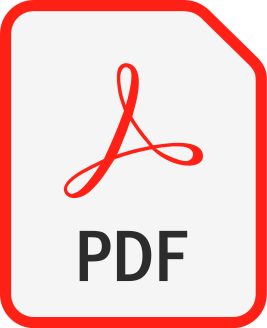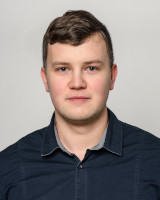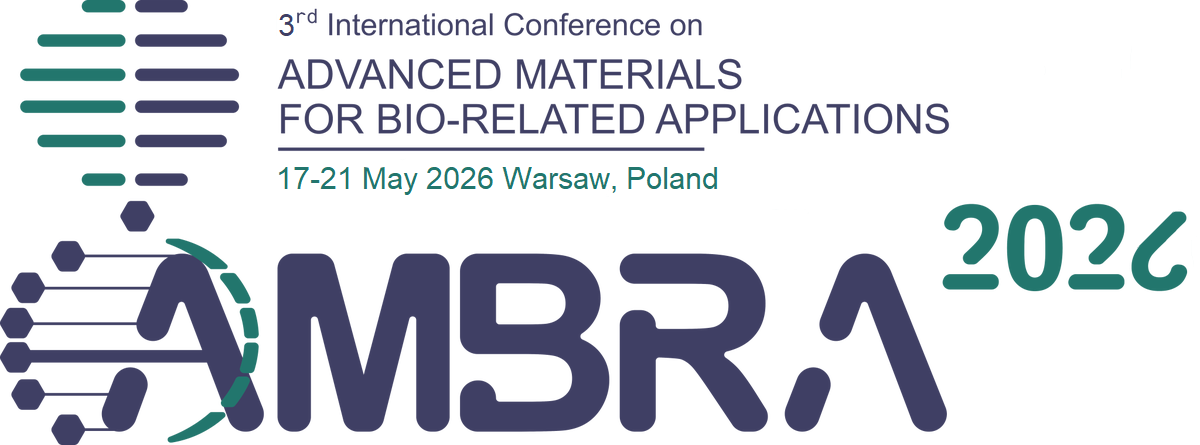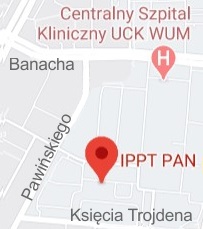| 1. |
Popławski B., Stoppel J., Ostrowski M., Wiszowaty R., Faraj R., Smart pneumatic airbag-type energy absorber - design and development,
SMART 2025, XI ECCOMAS Thematic Conference on Smart Structures and Materials, 2025-07-01/07-03, Linz (AT), pp.1-12, 2025 |  |
| 2. |
Pisarski D., Faraj R., Konowrocki R., Popławski B., Jankowski Ł., Magnetometer-based Particle Filter with enhanced velocity input for GPS-independent navigation of UAV,
SMART 2025, XI ECCOMAS Thematic Conference on Smart Structures and Materials, 2025-07-01/07-03, Linz (AT), pp.1-12, 2025 Abstract:
The contribution presents an original method for accurate positioning of an unmanned aerial vehicle (UAV) operating in GPS-denied environment, where GNSS signals may be jammed or spoofed. The proposed approach uses Particle Filtering with an enhanced velocity propagation model to estimate the UAV’s position within a magnetic anomaly field. The velocity is estimated based on data fusion of kinematic measurements from an Inertial Measurement Unit (IMU) and magnetic field readings from a scalar magnetometer, which are compared
with a magnetic anomaly map. Magnetic field measurements are incorporated at two stages. First, the rate of change of the magnetic field along the UAV’s trajectory is introduced into
the propagation model using the Bayesian inference to fuse IMU and magnetometer data for a more accurate velocity estimation. Second, measured magnetic field values are compared with the anomaly map to recalculate the particle weights and refine the position estimate. The proposed
method was validated using in-flight data. The UAV positioning error was significantly reduced. The results confirm the effectiveness of the proposed and emphasize the high performance of the Particle Filter with enhanced velocity propagation model compared to traditional
dead reckoning navigation. Keywords:
Magnetic Anomaly Navigation, Unmanned Aerial Vehicle, Particle Filter, Sensor Fusion, Bayesian Inference Affiliations:
| Pisarski D. | - | IPPT PAN | | Faraj R. | - | IPPT PAN | | Konowrocki R. | - | IPPT PAN | | Popławski B. | - | IPPT PAN | | Jankowski Ł. | - | IPPT PAN |
|  |
| 3. |
Pisarski D., Faraj R., Jankowski Ł., Popławski B., Konowrocki R., Magnetometer-based Particle Filter with enhanced velocity input for GPS-independent navigation of UAV,
AeroBest 2025, III ECCOMAS Thematic Conference on Multidisciplinary Design Optimization of Aerospace Systems, 2025-04-22/04-24, Lisbon (PT), pp.583-592, 2025 Abstract:
The paper introduces an original method for accurate positioning of an unmanned aerial vehicle (UAV) operating within a magnetic anomaly field. To estimate the UAV’s position in GNSS-denied environments, the proposed positioning method relies on particle filtering with an enhanced velocity propagation model. This approach employs
data fusion of kinematic measurements from the Inertial Measurement Unit (IMU) and magnetic field readings from a scalar magnetometer, which are correlated with a magnetic
anomaly map. Notably, this method utilizes magnetic field measurements in two distinct ways. Firstly, the rate of change of the magnetic field along the UAV’s trajectory is fed to the propagation model where the Bayesian inference is used to fuse the IMU and magnetometer measurements to estimate the particles velocity. Then, the absolute magnetic
field values are compared with a magnetic anomaly map to recompute the particles’ weights and refine the position estimate. The method was tested offline using in-flight recorded data. The analyses demonstrated the high performance of the particle filter with the enhanced velocity propagation model compared to dead reckoning navigation. As a result, the UAV’s position error was significantly reduced. The study also includes a discussion on the method’s robustness under different levels of IMU errors and the accuracy of magnetic field measurements. Keywords:
magnetic anomaly navigation, Particle Filter, Bayesian inference, unmanned aerial vehicle, sensor fusion Affiliations:
| Pisarski D. | - | IPPT PAN | | Faraj R. | - | IPPT PAN | | Jankowski Ł. | - | IPPT PAN | | Popławski B. | - | IPPT PAN | | Konowrocki R. | - | IPPT PAN |
| |
| 4. |
Mikułowski G., Pisarski D., Popławski B., Jankowski Ł., Vibration attenuation in a semi-passive frame,
SMART 2025, XI ECCOMAS Thematic Conference on Smart Structures and Materials, 2025-07-01/07-03, Linz (AT), pp.1-12, 2025 Abstract:
This contribution addresses the problem of adaptively tuning the parameters of semiactive devices to mitigate vibrations in structures subjected to unknown periodic excitation. Using a specially designed reinforcement learning algorithm, the semi-active devices adjust their operating parameters to ensure optimal dissipation of vibrational energy. The algorithm incorporates an efficient gradient-based sequence that ensures rapid convergence of the learning process and enables real-time implementation under varying excitation characteristics. The method is experimentally validated on a frame structure equipped with lockable joints, which can be controlled to adjust their stiffness parameters. Since the developed reinforcement learning algorithm incorporates partial knowledge of the structural model, the first part of the work is focused on formulating a simplified numerical model that is easy to identify and scale. Keywords:
Vibration attenuation, Reinforcement Learning, Semi-active control, Adaptive structure, Stiffness control Affiliations:
| Mikułowski G. | - | IPPT PAN | | Pisarski D. | - | IPPT PAN | | Popławski B. | - | IPPT PAN | | Jankowski Ł. | - | IPPT PAN |
|  |
| 5. |
Pisarski D., Faraj R., Jankowski Ł., Konowrocki R., Popławski B., Improving Positioning Accuracy using Particle Filter with Enhanced IMU Velocity Estimation,
ACC 2024, 2024 American Control Conference, 2024-07-10/07-12, Toronto (CA), pp.1-1, 2024 Abstract:
The study introduces a methodology that integrates a novel velocity estimation approach with the Particle Filter for accurately estimating the position of an object navigating within a magnetic anomaly field. To accurately determine position in GPS-denied environments, the acceleration measurements obtained from the Inertial Measurement Unit are augmented with magnetic field measurements and a previously designed magnetic anomaly map. Then, Bayesian statistics are employed to fuse information from the Inertial Measurement Unit and magnetometer, enabling accurate estimation of the object's velocity. The estimated velocity serves as input for the propagation model within the Particle Filter, which accurately predicts the object's position. This study showcases the efficacy of Bayesian-based velocity estimation in enhancing the classical Particle Filter approach, resulting in an approximate 40-55% reduction in the mean trajectory error. This refined methodology holds promise for applications across diverse domains, including GPS-independent navigation for vehicles Affiliations:
| Pisarski D. | - | IPPT PAN | | Faraj R. | - | IPPT PAN | | Jankowski Ł. | - | IPPT PAN | | Konowrocki R. | - | IPPT PAN | | Popławski B. | - | IPPT PAN |
|  |
| 6. |
Popławski B., Faraj R., Gabryel D.♦, ON INFLUENCE OF DELAYED ADAPTATION OF INFLATABLE SCTRUCTURE FOR EVACUATION OF PEOPLE AT HEIGHTS,
SMART 2023, 10th ECCOMAS Thematic Conference on Smart Structures and Materials, 2023-07-03/07-05, Patras (GR), DOI: 10.7712/150123.9803.444290, pp.1-9, 2023 Abstract:
Our study presents the research on elaboration of a novel type of the rescue air cushion, which is an inflatable structure used by fire brigades for evacuation of people at heights. The goal of our work is to increase its injury prevention capabilities. We consider the system based on an airframe filled with a compressed gas and a double-chamber airbag, which exchanges the air with environment. Discussed research includes modelling of the system, numerical simulations of its dynamic behavior and description of the dedicated adaptive solution. Practical implementations of the original ideas are conducted using the rescue cushion in 1:2 scale and a full-scale demonstrator of semi-passive valves. According to the already obtained results it is experimentally proven that a significant improvement of the system’s characteristics can be achieved by introducing valves of simple construction [1]. In this study the influence of a delayed start of the adaptation procedure is investigated in detail. Obtained conclusions are used in order to indicate directions of further system development, which will concern, among others, estimation of the impacting body trajectory and identification of the impact position. Keywords:
Adaptive Impact Absorption, Airbag system, Dynamic characteristics optimization, Impact mitigation, Rescue cushion, Pneumatic shock-absorber. Affiliations:
| Popławski B. | - | IPPT PAN | | Faraj R. | - | IPPT PAN | | Gabryel D. | - | other affiliation |
|  |
| 7. |
Ostrowski M., Jedlińska A., Popławski B., Błachowski B., Mikułowski G., Pisarski D., Jankowski Ł., Semi-active sliding-mode control for local mitigation of structural vibrations by means of on/off nodes,
SMART 2023, 10th ECCOMAS Thematic Conference on Smart Structures and Materials, 2023-07-03/07-05, Patras (GR), pp.538-548, 2023 Abstract:
This contribution presents a sliding-mode control approach for the mitigation of vibrations in frame-like structures. The control is implemented in a semi-active manner, that is, without significant external control forces and substantial power consumption, which are typical for active control approaches. Here, the control is achieved through dynamic, lowcost modification of properties at selected structural nodes. The employed actuators have the untypical form of two-state hinges, which can switch between two extreme states: no transfer of bending moments (effectively a hinge) and full transfer of bending moments (a locked hinge or a typical frame node). Consequently, the control forces are dissipative and coupled to the response. Previous research in this area focused on purely energetic considerations, aiming for global damping of vibrations. In contrast, this paper formulates the control objective in terms of local displacements of a selected degree of freedom, which can be interpreted as the task of isolating it from external excitations. This formulation is employed to define the target sliding hyperplane. The state of the actuators is chosen such that the effective control forces push the structural state toward the target hyperplane. The approach is verified in a numerical example of a six-story shear-type structure subjected to random seismic excitation. Keywords:
Structural control, Semi-active control, Sliding mode control, On/off nodes Affiliations:
| Ostrowski M. | - | IPPT PAN | | Jedlińska A. | - | IPPT PAN | | Popławski B. | - | IPPT PAN | | Błachowski B. | - | IPPT PAN | | Mikułowski G. | - | IPPT PAN | | Pisarski D. | - | IPPT PAN | | Jankowski Ł. | - | IPPT PAN |
|  |
| 8. |
Faraj R., Popławski B., Hinc K.♦, Preliminary study on modelling and optimization of the rescue cushion system,
ISMA2020 / USD2020, International Conference on Noise and Vibration Engineering / International Conference on Uncertainty in Structural Dynamics, 2020-09-07/09-09, Leuven (BE), pp.2675-2684, 2020 Abstract:
The paper is aimed at modelling and optimization of a rescue cushion system, which is a device used by fire brigades for evacuation of people from buildings. The goal of the study is an improvement of the system response under various operational conditions. For faster and cheaper analysis of the system performance and further development of the complex structure of the rescue cushion system, a dedicated dynamical model is elaborated. Implemented numerical model is further applied for the parametric study in order to evaluate the influence of selected airbag parameters on the effectiveness of impact mitigation process and to determine possible improvements of the actual system design. In particular, adaptation of the rescue cushion to the mass of landing person, as well as to the initial velocity, is analyzed. Simultaneously, the necessity of meeting all the functional and operational requirements is taken into account. The most promising directions of further research are indicated. Affiliations:
| Faraj R. | - | IPPT PAN | | Popławski B. | - | IPPT PAN | | Hinc K. | - | other affiliation |
|  |
| 9. |
Popławski B., Mikułowski G., Jankowski Ł., Semi-active decentralized mitigation of randomly excited vibrations in 2D frame structures,
SMART 2019, 9th ECCOMAS Thematic Conference on Smart Structures and Materials, 2019-07-08/07-11, Paris (FR), pp.357-363, 2019 Abstract:
Semi-active control systems are investigated for more than 40 years, and despite the great progress in this research area, they are still considered to be a complex topic in both theoretical and technical terms. However, their advantages ensure that these control systems remain an extremely attractive subject of scientific and technological development.
In this contribution, we present a semi-active strategy for mitigation of vibration, which utilizes an energy management approach called Prestress-Accumulation Release and is based on controllable activation and removal of selected structural constraints. Here, it is implemented by means of controllable structural nodes of a specific design that allow the transmission of moments between adjacent structural elements to be controlled in an on/off manner. The developed control strategy turned out to be very effective in damping of free structural vibrations of planar frame structures. Extension of the research to other types of vibrations has shown that the proposed control algorithm is versatile and stays efficient in a range of applications and different configurations of the investigated structures. This work is focused on mitigation of vibrations excited by a randomly generated force load.
Decentralization, understood here as controlling the employed actuators based on locally measured structural response, results in a decisive reduction of the complexity of the data acquisition and control systems, which is crucial for actual implementations in real structures, and which facilitates an ad hoc reconfiguration and expansion of the control system if necessary. It also provides the possibility of considering selected structural elements as separate energy dissipative devices, which in our approach act effectively as vibration dampers. This feature, provided by the decentralization, enables to take the advantage of two complementary, interrelated mechanisms of material damping: global dissipation of vibration energy by the PAR and local dissipation in single involved elements.
Numerical and experimental analyses indicate a high degree of effectiveness in alleviation of the amplitude of vibrations induced by a random transient force excitation. The proposed control strategy can be thus utilized not only in the case of momentary impulsive loads that result in predominantly free vibrations, but also in the case of transient random force excitation. It significantly extends the range of possible modes of operation of a structure equipped with the proposed damping system. Keywords:
Semi-active damping, Vibration damping, Random vibration, Forced vibration Affiliations:
| Popławski B. | - | IPPT PAN | | Mikułowski G. | - | IPPT PAN | | Jankowski Ł. | - | IPPT PAN |
|  |
| 10. |
Mikułowski G., Popławski B., Jankowski Ł., An experimental investigation of the prestress accumulation release strategy for local mitigation of structural vibrations,
SMART 2019, 9th ECCOMAS Thematic Conference on Smart Structures and Materials, 2019-07-08/07-11, Paris (FR), pp.323-332, 2019 Abstract:
This contribution presents an experimental analysis of the control system configuration for a semi-active frame structure. The structure is equipped with a system that implements a Prestress Accumulation Release strategy for mitigation of vibration. A proper distribution of the sensors for monitoring the actual state of the structure is the key factor that determines the overall effectiveness of the applied strategy. The results and findings presented here reveal a set of basic rules dedicated to solving this crucial issue. Keywords:
Prestress Accumulation Release, Vibration control, Sensor placement, Semi-active structures, Piezoelectric actuation Affiliations:
| Mikułowski G. | - | IPPT PAN | | Popławski B. | - | IPPT PAN | | Jankowski Ł. | - | IPPT PAN |
|  |
| 11. |
Mikułowski G., Popławski B., Wiszowaty R., Mróz A.♦, Jankowski Ł., An investigation on a semi-active damping of forced structural vibrations by means of controllable structural nodes,
ISMA 2018 / USD 2018, International Conference on Noise and Vibration Engineering / International Conference on Uncertainty in Structural Dynamics, 2018-09-17/09-19, Leuven (BE), pp.189-201, 2018 Abstract:
Vibration mitigation in space structures creates a unique class of a technical problem where resistant for outgassing and non-fluidic solutions are preferable. Additionaly, a vibration induced by time-varying excitations needs to be effectively reduced. The vibration mitigation task is speciffically difficult in the case of light, slender and inherently flexible structures of various types, such as supporting structures, deployable structures, modular structures or wide-span skeletal roofing structures. This study presents a concept of a vibration attenuation method based on semi-active joints and dedicated to frame structures under forced vibration excitation. The presented investigation contains an analysis of the problem of the optimal control of a structure fitted with semi-active structural members. Furthermore, an adequate model of the semi-active joints is developed and a numerical example is presented. Finally, the research provides an experimental verification of the developed control algorithms, which is conducted on a test stand in a laboratory environment. Affiliations:
| Mikułowski G. | - | IPPT PAN | | Popławski B. | - | IPPT PAN | | Wiszowaty R. | - | IPPT PAN | | Mróz A. | - | other affiliation | | Jankowski Ł. | - | IPPT PAN |
|  |
| 12. |
Popławski B., Mikułowski G., Mróz A.♦, Jankowski Ł., Decentralized algorithm for semi-active damping of forced vibrations using controllable truss-frame nodes,
WCSCM, 7th World Conference on Structural Control and Monitoring, 2018-07-22/07-25, Qingdao (CN), pp.582-590, 2018 Abstract:
Semi-active systems for mitigation of vibrations proved to be effective in many applications. Their prominent advantage is that they combine strong points of passive and active damping systems. Proper design can ensure their reliability, which is what passive systems are praised for. A high effectiveness in vibration damping links them with active systems. At the same time they do not have many deficiencies of active systems. They are adaptive, so they can stay effective in different environmental conditions, which is the factor that eliminates passive systems from many implementations. Their mass and energy consumption is very low, and the controlled structure can stay in the safe configuration even in case of power supply failure, which puts them in contrast to many active systems. The mentioned attributes make them a good choice for many structures subjected to vibrations, especially when there is a strong emphasis on maximization of the efficiency/mass ratio of the damping system.
This contribution presents a decentralized closed-loop control strategy and applies it in a frame structure equipped with controllable truss-frame nodes. Such nodes can be switched between frame-like and truss-like states in a controllable manner. In the frame-like state the node transmits all forces and moments, while in the truss-like state only axial and shearing forces are transmitted. These nodes allow for structural reconfiguration, which can be utilized by semi-active control strategies for the purpose of vibration damping. The implemented control algorithm applies the Prestress-Accumulation Release (PAR) strategy based on the transmission of the accumulated potential energy to high modes of vibration, which are highly dissipative. Strain measurements are conducted locally on selected elements. A similar strategy proved its effectiveness in mitigation of free structural vibrations. This research studies the concept of its application to mitigation of forced structural vibrations, caused by variable external conditions. Keywords:
Semi-active damping, Truss-frame nodes, Prestress-Accumulation Release (PAR), Decentralized control Affiliations:
| Popławski B. | - | IPPT PAN | | Mikułowski G. | - | IPPT PAN | | Mróz A. | - | other affiliation | | Jankowski Ł. | - | IPPT PAN |
|  |
| 13. |
Popławski B., Mikułowski G., Suwała G., Jankowski Ł., Optimization of actuator placement for vibration damping in the Prestress-Accumulation release control approach,
WCSCM, 7th World Conference on Structural Control and Monitoring, 2018-07-22/07-25, Qingdao (CN), pp.818-827, 2018 Abstract:
This contribution proposes a quantitative criterion for optimization of actuator placement for the Prestress–Accumulation Release (PAR) strategy of mitigation of vibrations. The PAR strategy is a semi-active control approach that relies on controlled redistribution of modal energy into high-frequency high-order modes, where it is effectively dissipated by means of the natural mechanisms of material damping. The energy transfer is achieved by a controlled temporary removal of selected structural constraints. An example is a short-time decoupling of rotational degrees of freedom in a frame node, so that the bending moments are no longer transferred between the involved beams. If it such a decoupling is performed at the maximum of the shear/bending strain energy of adjacent beams, it results in an almost instantaneous energy release into high-frequency local vibrations and quick dissipation of energy. We propose and test a quantitative criterion for placement of such actuators. The criterion is based on local modal strain energy that can be released into high-order modes. The numerical time complexity is linear with respect to the number of actuators, which facilitates quick selection of placements in large structures. Keywords:
semi-active control, damping of vibrations, actuator placement, smart structures, Prestress-Accumulation Release (PAR) Affiliations:
| Popławski B. | - | IPPT PAN | | Mikułowski G. | - | IPPT PAN | | Suwała G. | - | IPPT PAN | | Jankowski Ł. | - | IPPT PAN |
|  |
| 14. |
Popławski B., Mikułowski G., Mróz A.♦, Sekuła K.♦, Jankowski Ł., A decentralized strategy of structural reconfiguration in mitigation of vibrations,
Procedia Engineering, ISSN: 1877-7058, DOI: 10.1016/j.proeng.2017.09.363, Vol.199, pp.1683-1688, 2017 Abstract:
This contribution proposes a decentralized closed-loop control algorithm for semi-active mitigation of free vibrations in frame structures. The control uses dedicated dissipative devices, which consist of two controllable structural nodes placed pairwise in both ends of selected structural beams. The nodes are capable of a controlled transition between the standard frame mode of operation (full moment-bearing ability) and the truss mode in which they do not bear any moments and constitute in fact structural hinges. Synchronous switching is equivalent to reconfiguration of the global structure by (dis)allowing the involved beams to transmit moments and to accumulate vibration energy in the form of their bending strain. Upon switching to the truss mode, the accumulated energy is released into high-frequency local vibrations, which undergo quick dissipation by standard mechanisms of material damping. The approach is illustrated in a numerical example and verified in a preliminary experimental test. Keywords:
Mitigation of vibrations, Semi-active control, Decentralized control, Structural reconfiguration Affiliations:
| Popławski B. | - | IPPT PAN | | Mikułowski G. | - | IPPT PAN | | Mróz A. | - | other affiliation | | Sekuła K. | - | other affiliation | | Jankowski Ł. | - | IPPT PAN |
|  |
| 15. |
Faraj R., Popławski B., Suwała G., Jankowski Ł., Holnicki-Szulc J., Mitigation of dynamic response in frame structures by means of smart joints,
SMART 2017, 8th Conference on Smart Structures and Materials, 2017-06-05/06-08, Madrid (ES), pp.138-144, 2017 Abstract:
This paper discusses passive and semi-active techniques of structural control by means of smart joints, and then it proposes a specific smart joints system for frame structures and tests its capability in mitigation of free vibrations. Basically, the proposed solution modifies frame beams by addition of truss-type hinges, and its effectiveness relies on the softening effect that occurs in compression due to geometric nonlinearities and which triggers the highly-damped high-frequency response modes of the structure. First, the finite element (FE) model of the specific frame structure with geometrical nonlinearities is derived, and the proposed passive joints are described and incorporated into the model. Then, their principle of operation and effectiveness is examined numerically for the first two natural modes of vibrations with various initial displacement amplitudes. An objective function is proposed to assess joints placement, based on the efficiency in mitigation of the excited vibrations. Keywords:
Vibration Damping, Structure Response, Smart Structure, Structural Control Affiliations:
| Faraj R. | - | IPPT PAN | | Popławski B. | - | IPPT PAN | | Suwała G. | - | IPPT PAN | | Jankowski Ł. | - | IPPT PAN | | Holnicki-Szulc J. | - | IPPT PAN |
|  |
| 16. |
Popławski B., Mikułowski G., Mróz A.♦, Jankowski Ł., Decentralized damping of vibrations in 2D frame structures using controllable nodes,
SMART 2017, 8th Conference on Smart Structures and Materials, 2017-06-05/06-08, Madrid (ES), pp.94-103, 2017 Abstract:
Extensive research efforts have been recently devoted to semi-active structural control with its paradigms of smart self-adaptivity and low consumption of energy, which is used for local adaptation rather than to generate external control forces. Considered application areas include adaptive landing gears, seismic isolation systems, vehicle-track/span systems, power train electro-mechanical systems, damping of flexible space structures, vehicle crashworthiness, arctic engineering, wind turbines, etc. A part of the research concerns semi-active management of strain energy for damping of structural vibrations. Early works considered truss structures with stiffness-switched bars. They later evolved into either standalone one degree of freedom stiffness-switched dampers and isolators or investigations in triggering modal energy transfer to highly-damped high-order modes. The latter researches seem all to study the fundamental vibration mode of a cantilever beam with two detachable layers and differ mainly in the actuator technologies; the main idea is to employ actuators for a quick release of the vibration-related strain energy. This research extends the problem to general 2D frames. Controllable truss-frame nodes are incorporated into the structure. Thanks to their controllable ability to transmit moments, they allow for a quick transition between truss and frame modes. We propose a new, decentralized, closed-loop control strategy based on local energy measures. Vibration damping is more effective than in the previously studied control scheme based on a global energy measure, especially for higher vibration modes. Mitigation of vibrations will be presented in representative numerical examples, including a comparison to the global energy-based control strategy. Finally, results of experimental study, conducted on a structure analogous to the one from numerical simulations, will be demonstrated. Keywords:
Vibration damping, Smart structures, Semi-active control, PAR strategy, Decentralized damping strategy Affiliations:
| Popławski B. | - | IPPT PAN | | Mikułowski G. | - | IPPT PAN | | Mróz A. | - | other affiliation | | Jankowski Ł. | - | IPPT PAN |
|  |
| 17. |
Jankowski Ł., Graczykowski C., Pawłowski P., Mikułowski G., Ostrowski M., Popławski B., Faraj R., Suwała G., Holnicki-Szulc J., Adaptive Self-Protection against Shock and Vibration,
Advances in Science and Technology, ISSN: 1662-0356, DOI: 10.4028/www.scientific.net/AST.101.133, Vol.101, pp.133-142, 2017 Abstract:
This contribution reviews the challenges in adaptive self-protection of structures. A proper semi-active control strategy can significantly increase structural ability to absorb impact-type loads and damp the resulting vibrations. Discussed systems constitute a new class of smart structures capable of a real-time identification of loads and vibration patterns, followed by a low-cost optimum absorption of the energy by structural adaptation. Given the always surging quest for safety, such systems have a great potential for practical applications (in landing gears, road barriers, space structures, etc.). Compared to passive systems, their better performance can be attributed to the paradigm of self-adaptivity, which is ubiquitous in nature, but still sparsely applied in structural engineering. Being in the early stages of development, their ultimate success depends on a concerted effort in facing a number of challenges. This contribution discusses some of the important problems, including these of a conceptual, technological, methodological and software engineering nature. Keywords:
adaptive impact absorption, smart structures, semi-active control, safety engineering Affiliations:
| Jankowski Ł. | - | IPPT PAN | | Graczykowski C. | - | IPPT PAN | | Pawłowski P. | - | IPPT PAN | | Mikułowski G. | - | IPPT PAN | | Ostrowski M. | - | IPPT PAN | | Popławski B. | - | IPPT PAN | | Faraj R. | - | IPPT PAN | | Suwała G. | - | IPPT PAN | | Holnicki-Szulc J. | - | IPPT PAN |
|  |
| 18. |
Popławski B., Graczykowski C., Jankowski Ł., Controllable Truss-Frame Nodes in Semi-Active Damping of Vibrations,
Advances in Science and Technology, ISSN: 1662-0356, DOI: 10.4028/www.scientific.net/AST.101.89, Vol.101, pp.89-94, 2017 Abstract:
In recent years, vibration damping strategies based on semi-active management of strain energy have attracted a large interest and were proven highly effective. However, most of published research considers simple one degree of freedom systems or study the same basic example (the first vibration mode of a cantilever beam) with the same control strategy. This contribution focuses on truss-frame nodes with controllable moment-bearing ability. It proposes and tests an approach that allows the control strategy to be extended to more complex structures and vibration patterns. Keywords:
adaptive impact absorption, smart structures, semi-active control, safety engineering Affiliations:
| Popławski B. | - | IPPT PAN | | Graczykowski C. | - | IPPT PAN | | Jankowski Ł. | - | IPPT PAN |
|  |

















































